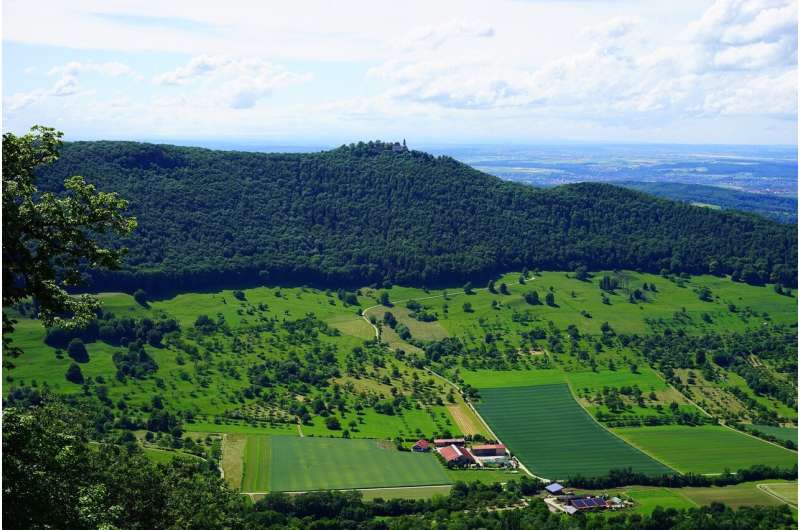Supercomputer simulations show that afforestation of grasslands can be counterproductive

Planting trees to combat climate change is a frequently and controversially discussed idea in recent times. Trees bind carbon dioxide (CO2) trough photosynthesis and could therefore remove this gas from the atmosphere for a certain period of time. However, when the trees die, for example, or if they are used as firewood, the greenhouse gas returns to the atmosphere. Furthermore, biogeophysical changes resulting from afforestation could also have consequences that call into question the possible benefits of this measure. This assumption is confirmed by the latest simulations carried out by Edouard L. Davin, Senior Scientist at the Institute for Atmosphere and Climate at ETH Zurich, on the Piz Daint supercomputer at the Swiss National Supercomputing Centre (CSCS). Together with an international team of scientists participating in a large-scale pilot study on how land use and climate influence each other across different scales (Land Use and Climate Across Scales Flagship Pilot Study), Davin shows that the reforestation of northern regions could even lead to a winter warming.
Land use change affects the climate
Land use change affects, among other things, the albedo of the Earth's surface, i.e. the amount of solar radiation that is reflected back to the atmosphere. For example, a snow-covered tree population at higher altitudes reflects much less solar radiation than a treeless landscape with a closed snow cover, resulting in a warmer environment. Similar feedback processes can also occur in the water cycle between the Earth's surface and the atmosphere when land use change impacts plant transpiration and evaporation of water (evapotranspiration). Even changes in the roughness of the Earth's surface can influence climate—the smoother a surface is, the less turbulence is generated in the lower atmosphere.
Until recently, it was difficult to quantify the extent of these biogeophysical effects. However, there is increasing evidence that changes in land use are driving local and regional climate change, writes Davin's team in their publication, which appeared in the journal Earth System Dynamics. The researchers therefore argue that the impacts of land use change should not only be taken into account in global models, as is currently the case, but also in regional climate models.
Improving regional climate simulations
They have now taken the first step in this direction with their latest study, which aims to integrate land use change into regional climate simulations across Europe. By comparing model simulations in which Europe is either maximally forested or without any forests at all, they attempted to quantify the biogeophysical effects of such land use changes on the regional climate. For the simulations—which the researchers describe as idealised experiments—they used a multi-model approach for the first time that included an ensemble of nine different regional climate models.
This ensemble of simulations with different combinations of land and atmospheric models enabled the researchers to compare the respective influence of atmospheric and land processes. They found that at maximum afforestation, the simulations across all nine models show temperatures over northern Europe average + 0.2° to +1° Celsius warmer in winter and spring than in a grassland landscape. According to the researchers, this is the direct result of reduced sunlight reflection (albedo) due to afforestation. For summer and autumn, however, the underlying models give a very heterogeneous picture, ranging from large-scale cooling of up to -2° Celsius to a warming of +2° Celsius following afforestation. The researchers suspect that this is due to the fact that the models show large differences in the evapotranspiration response to afforestation.
Coniferous versus broadleaf trees
The uncertainties in the simulations of the summer and autumn months clearly show the researchers that they must continue to improve their models. However, they are convinced that, despite idealised conditions, their multi-model approach could provide better and more reliable information for land use planning than individual models. "Another essential aspect to consider in future research is the type of trees used for afforestation," says Davin, echoing a study recently published in Scientific Reports in which he was involved. "Foresters tend to favour coniferous trees for economic reasons. But in many regions, broadleaf trees could be better adapted to a warmer climate and provide more cooling effect."
More information: Jonas Schwaab et al. Increasing the broad-leaved tree fraction in European forests mitigates hot temperature extremes, Scientific Reports (2020). DOI: 10.1038/s41598-020-71055-1
Edouard L. Davin et al. Biogeophysical impacts of forestation in Europe: first results from the LUCAS (Land Use and Climate Across Scales) regional climate model intercomparison, Earth System Dynamics (2020). DOI: 10.5194/esd-11-183-2020
Journal information: Scientific Reports
Provided by Swiss National Supercomputing Centre





















